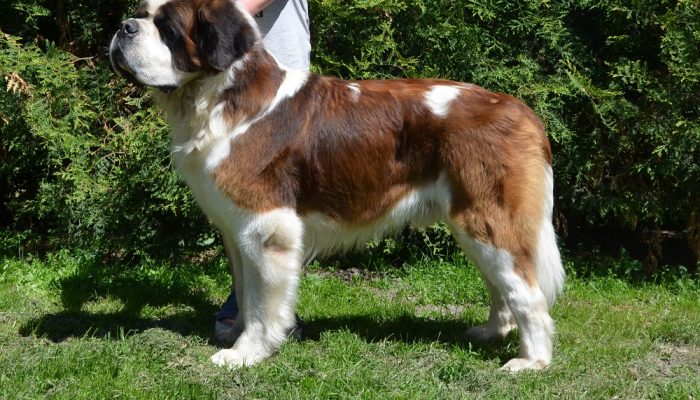About the breed St.Bernard
How to Grow a St. Bernard
The page translation is under construction. Text contains mistakes. Thank`s for understanding.
The St. Bernards make the impression of judicious, kind and very calm dogs. And it’s not just about impressive dimensions. A great kind heart and heroism are the main distinguishing features of this breed.
St. Bernard is a mobile, strong and enduring dog. Its size and powerful paws will not leave anyone indifferent. Initially, the St. Bernard dog served in mountain monasteries. Rescue heroes, these self-sacrificing dogs, saved thousands of people from cold death, and their innate intuition allowed them to predict the approach of crushing avalanches in the Alps.
Modern St. Bernards are sociable and sensitive animals. They are real family members who have not lost their key instincts
History
The breed of St. Bernards is named after the monastery of St. Bernard in the Swiss Alps. At the beginning of the XI century, the monk Bernard founded a monastery, a shelter and a transit point for travelers in the mountains, calling it his name. The peasants living on the territory of the monastery easily managed to tame the local half-wild dogs. These animals could boast of stunning dimensions, a desire to serve a person and amazing endurance. Each part of their body was as if created for active life in the harsh mountains. Quite quickly the priest began to use the general favorites as service dogs at the monastery. Over time, they were called St. Bernards. The site on which the monastery was located was at an altitude of 2,475 meters. The area around was difficult to access and dangerous for travelers because of frequent avalanches, heavy winds and mountain robbers.
In the XVII century the number of avalanches and their victims increased dramatically. Monks prudently decided to use St. Bernards to save travelers in the snow. Thick skin and a long thick coat protected the dogs from snow, wind and ice, and to the extreme developed sense of smell allowed finding unfortunate people even under meters of snow. Also, the St. Bernards accompanied the priests of the monastery during their long marches. These heroes possessed natural intuition and always unmistakably felt the approach of avalanches, saving lives not only for their companions, but for entire settlements located on the Alpine slopes.
If in those years it was possible to remove St. Bernard in the photo, we would be surprised how his appearance differs from that of a modern dog. Medieval dogs were not so massive and had greater mobility. The St. Bernards gained popularity, so they were attracted by European breeders. As a result of painstaking work, the dog began to look exactly as it is today.
The heroism of the St. Bernards could not go unnoticed. The most famous of them is a dog named Barry, who for the years of his life (1800-1812) saved the lives of forty people. Among them was a small boy, whom St. Bernard carried to the nearest hospital for five kilometers in deep snow. In 1899, in honor of this feat in Paris, a monument to the hero of Barry was erected, which at the moment is a favorite sight of Parisians and tourists.
Active breeding of pure breed according to all standards began at the end of the XIX century. At the moment, St. Bernards are used not only as rescuers and service dogs, but also as loving pets.
Intelligence
Many are convinced that the St. Bernards can not boast of a living mind and a developed intellect. The whole blame is a somewhat sad expression on their face and impressive size. In fact, the breed of St. Bernard is distinguished by excellent cleverness and the highest reaction speed. Their vocation is to save people in the mountains, and this requires a powerful intellect and lightning speed. Just in everyday life and under ordinary circumstances, the St. Bernards are not inclined to make unnecessary movements.
The St. Bernards cherish and love their masters, try to please them and rejoice in every possible way. Therefore, the process of their education always runs smoothly and with pleasure – both for the dogs themselves and for the owners.
One of the key manifestations of the intelligence of Alpine rescuers is an amazing ability to navigate in space. This is inherent in them at the genetic level. There are cases when the St. Bernards found their way home, passing through the mountains and deep snowdrifts of more than 50 kilometers.
Character
Thanks to a long life in the mountains, representatives of the St. Bernard breed have acquired a strong and strong character. These dogs never panic. Despite his calm and judicious nature (sometimes it seems that the St. Bernards do not strain and do not fuss as fact), they are always in full combat readiness to help people in trouble – not just the owners, but all around. Natural dedication is preserved even in dogs, whose upbringing has not been especially studied.
As well as it is necessary to true companions of the person, the St. Bernards are very obedient. They can afford special playfulness, stubbornness and pranks only in the age of puppies.
Socialization
St. Bernard is a family dog. His place is just next to people. He needs to communicate not only with man, but with animals-other dogs, cats, horses.
The main condition for maintaining St. Bernard is not to leave him alone. These dogs are very painfully experiencing loneliness and are subject to depression.
St. Bernards never show aggression. If on the street a small, bad dog attacks him with a squeal, in most cases the dog will not even notice her. But if St. Bernard is forced to protect his hosts in a difficult situation (for example, in the case of robbery attacks), he becomes an unbeaten opponent with a strong grip and a frenzied desire to punish the offender.
These dogs have a lovely soft character. They do their best to avoid conflicts and easily get along with all family members. St. Bernard especially likes the role of a nanny for young children. He entertains them, protects them from falling and allows them to sit on their horses. Many owners can show their St. Bernard on the photo, where he, harnessed to a sleigh, tirelessly rolls the kids over the snowdrifts.
Training
Do not be afraid of the size of St. Bernard. This dog is easy to learn and educate. It is characterized by excellent self-control, inborn discipline and a willingness to serve a person. Of course, all its potential St. Bernard can reveal only under one condition – the owner must love his pet and really respect him.
In the case of the St. Bernard punishment, rigidity and cruelty do not work. Moreover, it can be elementary simply to destroy trusting and warm relations, which are the meaning of friendship with the dog. Punishing St. Bernard for no reason, you will simply lower his self-esteem lower and lower, driving the Alpine giant into depression.
Remember, St. Bernards can not be kept on a chain. This is too thin a dog in terms of psychological organization. The chain kills in St. Bernard its dignity and main purpose – to be close to people, in every possible way protecting them.
As we have already said, St. Bernards can not be left alone for a long time. Especially, young dogs and puppies. With the onset of maturity, this will turn the dog into a nervous, insecure and even evil creature. Can you imagine what the crazed St. Bernard with its dimensions is capable of? If you need to leave the house, before your absence, walk the dog well, give it food and try to calm it down in advance – for example, try to put it to bed. And, of course, do not forget to leave the toys or turn on the TV.
Walking and exercise
If the owner takes care of the appropriate level of comfort, the St. Bernard dog can live peacefully in the apartment, despite its size. Of course, this is possible only if the dog regularly walks (every day and intensively), receiving the proper amount of physical exertion. But to overload the St. Bernard is not worth it. Slow running, relatively quiet games and hiking will be enough.
St. Bernards often became heroes of great novels. For example, Back – St. Bernard from the work of Jack London “Call of the Ancestors”. Also I want to remember the St. Bernard named Lel – the key character of the fantastic story of the Strugatsky brothers “The Hotel” The Dead Alpinist “”.
St. Bernards often became heroes of great novels. For example, Back – St. Bernard from the work of Jack London “Call of the Ancestors”. Also I want to remember the St. Bernard named Lel – the key character of the fantastic story of the Strugatsky brothers “The Hotel” The Dead Alpinist “”.
Care
Care for the St. Bernards will not give their owners a special hassle. Long-haired dogs need to comb every day with a brush with stiff bristles, short-haired St. Bernards – several times a week. Do not wash your pet too often – only in the process of contamination and necessarily using specialized soft shampoos that do not dry the skin and coat of the dog.
The St. Bernard breed has a very sensitive area around the eyes, so you need to wipe your eyes every day with a damp cloth. If severe purulent discharge develops, contact your veterinarian immediately.
Also, daily care requires the ears, teeth and mouth of the dog. For the St. Bernards is characterized by profuse salivation, so after each meal it is necessary to wipe the muzzle from excess saliva to avoid the formation of bacteria.
St. Bernard and your apartment
The controversy surrounding whether St. Bernard can be established in an ordinary city apartment has not yet been resolved by anyone. Indeed, the dog is very large and the country house is best for it. However, if you are able to provide the dog with sufficient air exposure, serious problems should not arise.
Despite its size, the St. Bernard dog will not seek to take over your entire territory. If possible, an adult St. Bernard can arrange a territory on a heated balcony with a heated floor. In warm and fresh air in winter, the pet will feel most comfortable.
Think in advance about how you will wash the dog. In the bathroom to do this is very problematic, so it is desirable to have a spacious shower in the apartment.
How to feed a dog of the St. Bernard breed
Puppies should be given food from a stand, the height of which can increase with the growth of the pet. To properly form the posture, it is necessary that the bowl is held on the line of the dog’s chest.
Dry food for the St. Bernard breed must belong to the “premium” or “super premium” class. It is necessary to strictly observe the dosage indicated on the pack. With a natural diet, the animal is fed twice a day (on hot days it can be once, in the evening). A one-year-old dog should receive 500 grams of meat or sea fish daily, 200 grams of vegetables and cereals, and 400 grams of cottage cheese. Meat is cut into pieces, fish are removed from the fish. Puppies for the development of teeth are useful to gnaw the tendons, adult dogs – bones (not birds) and cartilage.
14.06.2018 Natalia Kachmar


